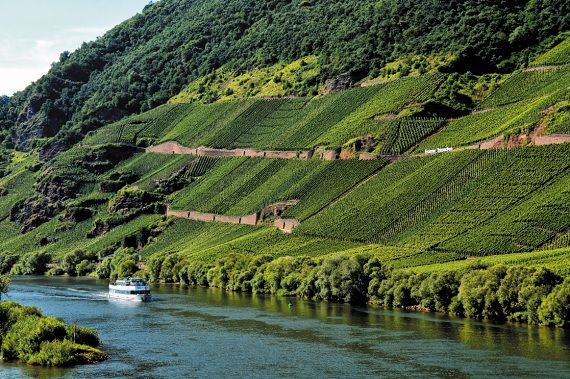_________________________________________
DESPITE THE EXTREME water shortages, this year’s German wine harvest has turned out to be unexpectedly high, according to the German Wine Institute (DWI).
After last year’s below-average crops and correspondingly depleted cellar stocks, latest estimates expect a wine must harvest nationwide of approximately 10.7m hl.
The institute says this would correspond to a 23% rise over the 10-year mean of 8.8m htl, resulting in the largest harvest since 1999. The estimated volume increases vary between the regions, ranging from 5% in Saale-Unstrut, to 36% in the Mosel and up to 64 % in the Mittelrhein.
The DWI says this summer’s drought has been more beneficial than harmful for vine development and berry ripening. Thanks to the hot, dry conditions, the grapes showed themselves right up into October to be in excellent health, with rich aromas and high ripeness levels. Red wine varieties have benefited especially from the hot summer. Care has been taken with picking times to ensure that the grapes do not come into the cellar with too high must weights, so as to prevent the wines becoming excessively powerful.
All seems well in German vineyards and wineries. Now on to the commercial stuff.
Ernie Loosen, owner of Mosel specialist Loosen Bros, puts German wines into perspective. “Germany still has an important place in the global wine market because of our long history and rich traditions, not only with Riesling, but also the Pinot varieties and other classic grapes that can be grown in certain regions.
“Riesling is still our lifeblood, however, especially in the Mosel region. Riesling will always be a niche wine, it seems, because of its aromatic, in-your-face nature and its unique ability to be produced in a full spectrum of styles. Its very diversity can cause confusion among average consumers, but Riesling is a wine that inspires passionate devotion in a lot of wine lovers,” says Loosen.
Richard Jones, managing director of Reh Kendermann UK, says: “German wine has virtually moved from the uncomfortable position of being one of the largest suppliers of entry-level wines in the UK and some other markets to a more niche producer of exciting, cool-climate wines.
“The move to drier, more food-friendly wines has been a significant trend over the past 20 years and this style is the norm in Germany. Export markets are somewhat behind the curve, but we are seeing the more wine-engaged consumer picking up these wines,” says Jones.
“Reh Kendermann has been very successful in managing this transition. We have grown our market for the traditional off-dry wines with Black Tower, which is by far Germany’s most successful export wine brand. Black Tower has engaged the consumer through innovative packaging and carefully developed range extensions tailored for individual markets, such as lower and no alcohol variants and the organic and vegan Sparkling Ice,” Jones says.
Franz Wilhelm Langguth Erben CEO Patrick Langguth, says: “In terms of total wine production, Germany is in the mid-range of the producing countries with about 9-10m hl. For white wine, Germany is one of the leading nations in quality worldwide.”




